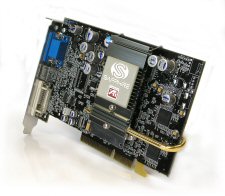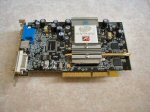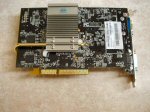Looking for a fast, but quiet, video card? Sapphire’s 9600XT Ultimate uses passive cooling to make it completely silent!
Introduction
I was hesitant when Scott offered to let me review an ATi RADEON 9600XT video card. The last ATi graphics processor in one of my systems was a 2D-only Mach64. That was back in the days when even 2D video caused Windows and DOS driver headaches, so I was by no means an ATi fan boy based on my Mach64 experience. My initial 3D card was from Rendition, but ever since the first TNT was produced, I’ve been strictly an NVIDIA man. I must admit, though, I’ve been curious about the current generation of ATi RADEON graphics processors. So with an equal mix of curiosity and wariness, I agreed to pop a 9600XT into my system.
The RADEON 9600XT is the hotrod board in the 9600 family. The XT features a core speed of 500 MHz versus the 325 MHz of the standard 9600 and 400 MHz of the PRO. Memory speed for the XT and PRO is at least 300MHz DDR (600MHz effective) compared to the 9600’s 200MHz DDR (400MHz effective). The review card, a RADEON 9600XT Ultimate from Sapphire, is even more special. Not because it’s hopped up, but because it uses passive cooling, meaning it uses a big, honking heatsink and heatpipe. Silent PC lovers, this one’s for you! The 9600XT Ultimate is absolutely silent – it has no moving parts. An elaborate heatsink handles all the cooling. The tradeoff, however, is 300MHz DDR memory (600MHz effective) compared to 325MHz DDR (650MHz effective) to Sapphire’s fan-cooled 9600XT’s.
Features
- Frame Buffer: 128MB DDR
- Memory Interface: 128-bit
- Rendering Pipelines: 4
- Pixel Fillrate (Gpixels/sec): 2.0
- Engine Clock (MHz): 500
- Memory Clock: 300MHz DDR (600MHz Effective)
- Output Connections: VGA + TV + DVI
- AGP 8X support
- SMARTSHADER 2.0
- SMOOTHVISION 2.1
- HYPER Z III+
- TRUFORM 2.0
- VIDEOSHADER
- FULLSTREAM video de-blocking technology
- Dual integrated display controllers
- Integrated TV Output support up to 1024×768 resolution
- Catalyst Driver Install CD
- PowerDVD XP Install CD
- Redline Tweak Utility CD
- Molex Power Supply Splitter
- DVI to VGA Converter
- S-Video to Composite Converter
- Composite Lead
- S-Video Lead
- Tomb Raider Angel of Darkness Game Disk
- Half Life 2 Game redemption voucher
It’s very clear that ATi leads the industry in HYPERBOLE, at least as far as trademarked features go. Attention ATi’s attorneys: I’m just kidding!
The main appeal of the Ultimate version of the card is obviously its silence. The heatsink has to be seen to be believed. It covers both sides of the PCB and features a heatpipe between the two halves. Each half rises 30mm from the PCB, and the entire heatsink is 52mm from top to bottom. It’s big, but doesn’t intrude into the neighboring PCI slot on the motherboard. The board uses a compact form factor, so in addition to be being quiet it stays out of the way of stray items on the motherboard.
The 9600XT optionally features ATi’s “OVERDRIVE” utility. OVERDRIVE allows you to change the core clock speed through the video display properties. This is different than using Powerstrip because the graphics processor utilizes a thermal diode to determine the appropriate amount of overclocking. In other words, the OVERDRIVE function won’t let you fry the graphics processor. There are two core speeds available through OVERDRIVE; 513 MHz and 527 MHz. The thermal environment will determine which speed is appropriate. Sapphire includes a utility called “Redline” to tweak the RADEON to extremes, including the ability to overclock the core and also the memory. Using Redline encompasses the same risks one would take by using a utility such as Powerstrip to overclock, however. Redline also allows you to tweak many driver, D3D, and OpenGL settings as well as creating custom game profiles. We will test both OVERDRIVE and Redline in this review.
The accessories in the package are standard fare for most cards, but are well thought out. TV-Out cables are of sufficient length (6 feet) to actually reach a TV that’s not sitting on top of the desk. The inclusion of the S-Video to Composite Converter is a nice touch for people with older TV’s. The bundled software includes Cyberlink’s “PowerDVD” and the full version of “Tomb Raider: Angel of Darkness.” The review card came with a Half-Life 2 redemption coupon and Sapphire’s Web site still lists HL2 as being available. There have been news reports on the Web that ATi is discontinuing the HL2 giveaway, so you’d better get a Sapphire RADEON from existing stock to ensure the coupon is present. Unfortunately, a retail receipt is required for redemption so this reviewer will still have to buy his own copy. I know, that breaks your heart.
Performance
Most of the performance testing for the card was done with Bench’emAll. BenchemAll is a utility that performs benchmark runs in batch mode. Supported games and benchmark programs include “Halo”, “Call of Duty”, “Unreal Tournament 2003”, “3DMark03”, and quite a few others.
The Sapphire ATi RADEON 9600XT Ultimate was compared to MSI’s GeForce FX5700 Ultra-TD128. The 5700U is the 9600XT’s closest competitor in NVIDIA’s lineup, and it features a core speed of 475 MHz and DDR2 memory speed of 900 MHz.
Test System:
- Motherboard: Biostar nForce2 M7NCD Pro
- Processor: AMD Athlon XP 2500+ (Barton)
- Memory: 256MB Corsair XMS PC3200 DDR SDRAM, 256MB OCZ PC3500 DDR SDRAM
- Hard Drive: Western Digital 120GB ATA100 HDD
- Operating System: Microsoft Windows XP (with Service Pack 1)
Video Card Drivers:
- ATI Drivers: Catalyst 4.1
- NVIDIA Drivers: ForceWare 53.03
- DirectX Version: 9.0b
All tests were run with maximum detail settings!
Benchmark Programs
AquaMark3
|
|||||||||||||||||||||||||||||||||||||||||||||||||||||||||
AquaMark3 is Massive Development’s commercial benchmarking program that utilizes the game engine from the eye candy games “AquaNox” and “AquaNox 2: Revelation.” The RADEON has a bit more horsepower than the NVIDIA card when anti-aliasing and anisotropic filtering are enabled, but both cards are breathing heavy to crank out the frames.
Games
Splinter Cell (version 1.2b)
|
|||||||||||||||||||||||||||||||||||||||||||||||||||||||||
The cards were extremely close in this real game competition, with the 9600XT winning out by a few FPS. This game, or at least the benchmarking demo, doesn’t appear to be quite as taxing as some other current titles.
Tomb Raider: Angel of Darkness (version 49)
|
|||||||||||||||||||||||||||||||||||||||||||||||||||||||||
The v49 patch of the latest installment in the life of Lara Croft introduced a benchmarking demo. It was promptly pulled out of the subsequent patch a few weeks later. No official explanation was given, but the rumors on the Web were that NVIDIA cried foul over the scores its cards received. Given the relative parity of our tests, NVIDIA was probably right to complain. Whether it was intentional or not, this particular demo isn’t very useful for measuring NVIDIA cards. Regardless, the 9600XT’s scores indicate that an awful lot of silicon is needed to run what is essentially a crappy sequel in a long line of crappy sequels.
Halo (version 1.03)
|
|||||||||||||||||||||||||||||||||||||||||||||||||||||||||
Halo is an extremely tough pixel pusher, and its scores reflect the need for leading edge hardware to get maximum frames per second from it. Pretty amazing how the Xbox port can run well on relatively slow Microsoft/Intel/NVIDIA hardware, but the addition of pixel shaders and higher resolution graphics cripples even the latest crop of graphics processors.
Unreal Tournament 2003 Botmatch (version 2225)
|
|||||||||||||||||||||||||||||||||||||||||||||||||||||||||
Going back to a somewhat older game like UT2K3 gives the cards a chance to breathe and churn out some frames. Neither disappoints, even with all settings maximized. The 5700U comes out slightly on top in this test.
Performance continued
TV-Out
Displaying PC output on a television has never been high on my list of Fun Computing Things, but given ATi’s positioning as a multimedia graphics provider it seemed an appropriate time to show some interest. As luck would have it, a recent kids sleep-over at my house (relax, my last name isn’t “Jackson”) gave me a great opportunity to test out the 9600XT’s TV output. The kids wanted to see a video I had on the PC in MPEG4 format. Considering that it takes hours to transcode and write a full-size MPEG4 file to DVD, porting the video to TV seemed like a good option. As previously noted, Sapphire includes S-Video and Composite cables 6 feet in size. The S-Video to Composite Converter also came in handy since my TV only had a Composite video input and the 9600XT has a S-Video output jack. Enabling the PC for TV output is extremely easy using ATi’s supplied driver utilities. The process is well-documented in both Sapphire’s instruction manual and in ATi’s installed help files. A minor glitch occurred when attempting to view the output of the MPEG4 (DivX) file, however. The media player displayed a blank screen whereas the PC showed the video in all its compressed glory. A quick search of DVDRHelp.com revealed two simple Display Property changes that allowed the video to play on the TV full screen.
Display quality was reasonably good. It wasn’t quite VCR quality (the source file wasn’t all that great, either), but it was certainly sharp enough to be viewable. Again, the immediate availability of the data versus waiting hours to use it on DVD made this an extremely viable alternative. The size of the included cables and ease-of-use of ATi’s utilities added to the overall high value of TV-Out with this particular video card.
Visual Quality
As noted in my review of MSI’s FX5700 Ultra, the 9600XT appeared to me to produce sharper game graphics with noticeably deeper and richer colors. This is an entirely subjective test, of course, but after years of NVIDIA-only viewing the difference between the two cards was tangible. The RADEON was visibly superior to my eyes.
Overclocking
The 9600XT Ultimate comes with two means of overclocking the card. ATi’s OVERDRIVE utility is supported through the driver tabs in the Video Display Properties. As stated in the introduction, OVERDRIVE uses a thermal diode to detect core temperature and overclock where appropriate. It’s a safe, and supported, method for gaining up to 27MHz in core speed.
To test OVERDRIVE, I used Futuremark’s 3DMark2001 SE to benchmark the card at its default clock speed of 500MHz to what the OVERDRIVE tab reported as 526MHz. Note: Bjorn3D no longer uses 3DMark03 due to driver constraints within the End User License Agreement.
3DMark2001 SE (build 330)
Overclocking core with OVERDRIVE
|
|||||||||||||||||||||||||||||||||||||||||||||||||||||||||
OVERDRIVE gave the card a nice little speed boost with no ill effects. The heatsink cooled the GPU sufficiently to maintain the new core speed throughout an extended test session. It must be noted that your results will be dependent on your system’s operating environment. My large Antec case has never been a hot runner. Standard case fans keep it cool enough. A small, tightly packed case may significantly raise operating temperatures and negate the effectiveness of OVERDRIVE.
Overclocking memory with Redline
Overclocking core with OVERDRIVE
|
|||||||||||||||||||||||||||||||||||||||||||||||||||||||||
Keeping the core at 526MHz, I used Sapphire’s Redline utility to bump up the memory speed to 325MHz (the speed their fan-cooled 9600XT’s operate at). There were no stability issues, however the video quality did show some anomalies during the 3DMark2001 game tests. They weren’t particularly noticeable, so someone looking to squeeze every last FPS out of a game may wish to keep the speed at 325MHz. However, for those averse to stability or graphic imperfections it’s probably advisable to crank down the memory speed a few notches. The Redline test did prove the usefulness of the utility and that the passively cooled memory still has some untapped speed within it.
Conclusion
The Sapphire RADEON 9600XT Ultimate would be a very nice video card even with a noisy fan. It meets or exceeds the benchmarks set down by its NVIDIA competitor, it comes with a TV-friendly bundle, and if you get the right box, it may also come with Half-Life 2. On top of those attributes, the card was rock steady throughout our testing and games played on it looked wonderful. Its final, and perhaps best, quality is the fact that it runs silently. With no fan stirring things up, the 9600XT Ultimate should make even the most ardent white noise hater happy. The Ultimate, even with passive cooling, can be reliably overclocked as well. Finally, the Ultimate is reasonably priced in an affordable segment. We found one for sale at Newegg.com for approx. $195.
Based on its speed, affordability, features, and absolute silence, we award the Sapphire 9600XT Ulimate a 9 out of 10 Bear Paws and Bjorn3D’s Golden Bear Award.
 Bjorn3D.com Bjorn3d.com – Satisfying Your Daily Tech Cravings Since 1996
Bjorn3D.com Bjorn3d.com – Satisfying Your Daily Tech Cravings Since 1996














